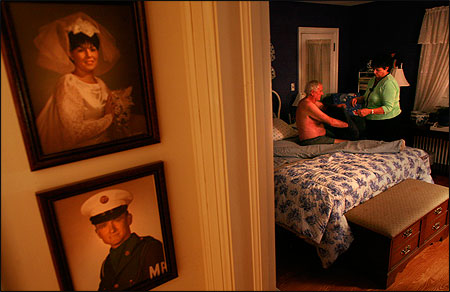
Beth Macy documented the struggles of family members and paid helpers caring for the frail elderly in her 10-part series, “Age of Uncertainty.” Photo by Josh Meltzer/The Roanoke Times.
Notes from a recent week on the family beat at The Roanoke (Va.) Times, the 88,000-circulation paper where I’ve spent most of my career:
- Made calls for a possible story on a truck driver who reunited with his daughter in Germany via Skype after being apart for nine years.
- Followed a story tip from my 16-year-old who announced recently that he wanted to go to the Seven Gates of Hell, an allegedly haunted farm that turns out to be scary for reasons unrelated to the paranormal.
- Used a video camera and old-fashioned note taking to interview teens, police and farm owners, including the wife of the alleged “coke-snorting ax murderer,” who is actually just an angry landowner sick to death of trespassing teens. (Favorite quote: “No, no. He does not threaten them with an ax. He carries a shotgun.”)
- Prepped for an upcoming trip to Haiti to report on a local mission worker who’s been instrumental in post-earthquake recovery.
- Finished fact checking 300 inches of copy for a three-part series I wrote on the controversy engulfing Lyme disease, which is newly endemic in our region.
- Spent 12 hours editing the Seven Gates video (my first) and six hours writing the story, only to learn from a much younger colleague that the video wasn’t good enough to post but the story is running on the front page.
- Attended a mandatory training session on libel where the takeaway was don’t write anything bad about a source in a personal e-mail, ever.
Then I spent the rest of the week worrying about the following: mean e-mails I’ve written about sources, the recent cholera outbreak in Haiti, and God-knows-how-many ticks I just picked up tromping around the Seven Gates of Hell.
Things on the family beat were infinitely easier back in the good old days, right?
The Family Beat
When I came to The Roanoke Times in 1989, I was a generalist. I gravitated toward features about funny things—Southerners’ enduring fixation with tomato sandwiches, for instance. Or teenage Dumpster divers. Or a 9-year-old boy who was obsessed with vacuum cleaners. But most of the time I wrote about serious stuff—teen pregnancy, race relations, a lawyer with stage four melanoma who bucked doctors’ advice to get her affairs in order and took up marathon running instead.
When I moved from features to news to become the family beat reporter, editor Carole Tarrant said she wanted to elevate such stories to the front page. In the past the beat had lingered at our paper, often tasked to reporters who were busy covering other things—this, in a slow-news city that’s constantly touted as a great place to raise kids.
In the 1980’s and 1990’s, the family beat was lumped in with coverage of social services—adoption issues, foster care, welfare and the like. Then it became part of our health care beat. When I took over the family beat in 2007, it finally stood on its own. Our staff size had shrunk considerably, like everyone else’s, and remaining staffers were challenged to juggle more things than ever while also learning all things online.
But my editor didn’t cut family coverage at our paper; she gave it a promotion. Clearly, this wasn’t happening everywhere. When I judged the Casey Medals competition at the Journalism Center on Children & Families in 2008 and again in 2010, I wasn’t the only person who noticed a decrease in both the quantity and quality of the entries, especially from smaller markets like ours.
The family beat wasn’t just an afterthought anymore; it seemed to be altogether estranged from the newspaper.
The Family Blog
Meanwhile, “mom” blogs and columns emerged to pick up some of this reporting slack. At The New York Times, Lisa Belkin filled us in on the Motherlode, Michelle Slatalla on what it was like to be a Wife/Mother/Worker/Spy, and Paula Span on the challenges of caregiving in The New Old Age. These are promising developments, according to this middle-aged feminist who remembers when most newspapers rarely deigned to cover family life—you know, that thing we spend 80 percent of our lives thinking, planning and fretting about.
In a midsized market like ours, I’m privileged to be able to continue to tell in-depth and intimate stories about real people and their joys and struggles—from a 10-part series on caregiving to a feature on teen pranksters who set out chasing ghosts in a cow pasture, only to run up against a shotgun-wielding farmer. They are enterprising local stories that people won’t find anywhere else—except in living rooms and around kitchen tables. If we tell them well, it won’t matter what medium we use. They can be our saving grace.
Covering families at a mid-sized newspaper is a lot like mothering. You laugh. You cry. You never know what will happen next. This week I found myself doing a dozen things I never planned on doing—climbing over cattle gates (in a skirt), detaching audio from a video clip, interviewing a Yale researcher about the mating habits of ticks. Then I cashed another paycheck and wondered for the millionth time: Really? They pay me for this?
Beth Macy, a 2010 Nieman Fellow, is the family beat reporter at The Roanoke (Va.) Times. In 2007 and 2009 she won awards in the Casey Medals contest for her coverage of children and families.



